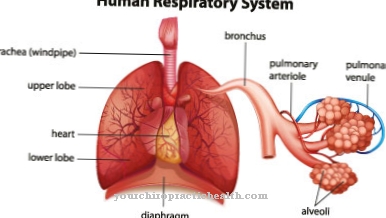The Bromhidrosis, also as Bromhidrosis is a special form of hyperhidrosis, abnormal sweating. With bromhidrosis, those affected suffer from abnormally excessive sweat secretion.
What is bromhidrosis

© andriano_cz - stock.adobe.com
The increased sweat secretion causes an excessive secretion of sweat. The body normally creates a certain amount of sweat to regulate body temperature. With a correspondingly warm ambient temperature, large amounts of sweat are physiological, not the case with bromhidrosis.
Here the sweat glands constantly produce excess sweat, which can quickly become a problem for those affected due to unpleasant body odor and constantly wet clothing. Bromhidrosis is medically defined as a disease of the apocrine sweat glands.
The horny layer of the skin is pathologically moisturized by the constant overproduction of sweat, which among other things also leads to an increase in the bacterial flora. Sweat is usually odorless, and the typical unpleasant smell of sweat arises only after it has been decomposed by bacteria.
This smell spreads mainly to the parts of the body that have a high number of sweat glands, i.e. armpits, groin region, feet but also skin folds.
causes
Overlapping areas of the skin affected by bromhidrosis are particularly prone to infection. The increased skin moisture leads to an increased colonization of germs by bromhidrosis in these skin areas.
What leads to the constant overproduction of sweat in hyperhidrosis or bromhidrosis as a special form is not known. Dermatologists assume that it is a congenital metabolic disorder. The disease can break out in childhood, but also in later adulthood; the time at which the disease breaks out seems to be directly related to the individual genetic disposition.
Obesity also plays a role as a cofactor in all forms of hyperhidrosis. There are 2 forms of bromhidrosis, the apocrine and eccrine form. The typical smell of an individual is determined by the apocrine sweat glands. As a result of the increased secretion of eccrine sweat, keratin is softened, and when it is broken down by bacteria, a very unpleasant foul odor is created.
You can find your medication here
➔ Drugs against sweating and sweatingSymptoms, ailments & signs
Bromhidrosis is usually associated with increased sweat production. Those affected sweat even with light physical exertion, and this leads to inflammation, mental problems and other complaints. The disease puts stress on the skin and glands.
Long-term or chronic illnesses in particular can lead to inflammation under the armpits, on the legs and in the genital area. Rubbing clothing and irritating care products increase this effect and lead to increasing skin irritation in the long term. Pathogens can settle on the weakened skin, which can lead to infections, eczema and acne.
Many sufferers also suffer from pain and sore skin. If bromhidrosis is not treated, this has a negative effect on the emotional state of the person concerned. The increased perspiration is usually also associated with an intense odor development - both of which restrict those affected in social situations.
There may be withdrawal from social life and the development of serious psychological complaints. Externally, bromhidrosis can be recognized by rapid perspiration. In individual cases individual pores are inflamed or extensive reddening occurs under the armpits or in the genital area.
Diagnosis & course
The suspected diagnosis of any form of hyperhidrosis can be made based on the symptom of increased sweat production. The extent and severity of the pathological perspiration are then the subject of further investigations.
In the case of bromhidrosis as a particularly fulminant course, sweat measurements can also be carried out to confirm the diagnosis. These take place under controlled outpatient conditions at a dermatologist or in a dermatology clinic. Fine fleece cloths are placed in the affected skin areas for a defined period of time, then weighed.
This means that the amount of sweat produced can be extrapolated very quickly in 24 hours. However, before the diagnosis of bromhidrosis is made, a detailed sweat analysis is also required to determine its chemical composition.
If there is bacterially decomposed skin keratin in the sweat sample, the eccrine sweat glands are also affected and the suspected diagnosis of bromhidrosis is confirmed. In addition, individual sweat glands can be removed under local anesthesia to confirm the diagnosis and examined in the histological laboratory.
Complications
Bromhidrosis can cause various complications. Maceration, a watering of the skin that is associated with permanent cell damage, often occurs. The excessive perspiration also increases the risk of fungus and itching. As a result of bromhidrosis, athlete's foot or jock itch are particularly common, but also warts and bacterial infections, which can cause further diseases.
The strong body odor and the noticeable complexion can also lead to social and emotional complications. Complications can also arise in the treatment of bromhidrosis. If the sweat glands are suctioned off, there is a risk of inflammation, infection, wound healing disorders and bleeding; in addition, nerves can be injured, which can lead to permanent sensory disturbances.
In rare cases, these nerve injuries lead to Horner's syndrome, a secondary disease of bromhidrosis, which manifests itself in constricted pupils and drooping upper eyelids.Treatment with botulinum toxin can lead to temporary muscle relaxation in the affected region. As a result of treatment using endoscopic trasthoracic sympathectomy, heavy night sweats can occur in the meantime, which is often expressed in other parts of the body.
When should you go to the doctor?
If bromhidrosis occurs again, a doctor should definitely be consulted to determine the cause. There may be a disease behind the increased sweat production. However, it can also be a consequence of drug treatment. If the bromhidrosis is not restricted by hygienic measures, many patients will turn to a doctor anyway to get rid of the foul smelling sweat odor.
Often, psychological problems also arise as a result of bromhidrosis, which can then only be treated with the help of a psychologist.Without professional psychological help, bromhidrosis often quickly leads to social isolation. In addition to the psychological problems, there can also be other complications with bromhidrosis, which make consulting a doctor urgently necessary.
This is especially true in the case of agonizing itching, stubborn skin and athlete's foot infections or warts. If the doctor cannot find a cause for the increased perspiration, the patient must be referred to a dermatologist. This then tries to limit the reproduction of fungi and bacteria through various measures. But sometimes that is not enough either.
In particularly severe cases, the doctor will have to decide to surgically remove the sweat glands. This is an operation that can only be carried out by experienced doctors, because there is a risk that nerve endings will also be injured, resulting in permanent sensory disturbances.
Doctors & therapists in your area
Treatment & Therapy
The cause of abnormal sweating is still unknown today, so a causal, i.e. cause-related therapy of any form of hyperhidrosis is not possible. However, a treatment concept has been established that has also found its way into a guideline concept of the Society for Dermatology.
Commercially available deodorants show no effect on bromhidrosis as a severe severity of hyperhidrosis. However, it has been shown that medical, metal-containing antiperspirants have an antibacterial effect in addition to the antihidrotic effect. Due to the increased proportion of aluminum chloride, these deodorant preparations require a prescription; the treatment results are particularly promising for hyperhidrosis axillaryis.
But with bromhidrosis, other parts of the body and also the skin folds are typically affected by the increased uncontrolled perspiration. In addition, aluminum, as a heavy metal, is suspected of being able to overcome the skin barrier and trigger serious side effects up to and including the development of tumors when used in high doses and in continuous use.
Permanent hair removal with laser treatment does not lead to reduced perspiration, but the consequences of bacterial decomposition of perspiration can at least be mitigated. In the case of a fully developed clinical picture of bromhidrosis, the last resort is surgery. It is a procedure under general anesthesia in which large parts of the sweat glands in the armpit or other skin areas are removed.
Outlook & forecast
Bromhidrosis must be treated in any case. In this disease, there is no other positive course of the disease and no self-healing either. Ordinary deodorants usually do not help with this condition either.
In severe cases, those affected have to have the sweat glands removed from under the armpits or other regions. This is the only way to completely limit abnormal sweating. If an operation is not desired, the person affected can also use various deodorants that have a high proportion of metals.
Although these can reduce perspiration, they are carcinogenic and can have other serious side effects. For this reason, these care products should not be used over a long period of time.
Without treatment, bromhidrosis leads to very profuse sweating and thus to various restrictions in the patient's everyday life. If the sweat glands have been removed, the symptoms do not recur. In some cases, hair removal can also have a positive effect on the course of the disease, as it can prevent bacterial infections. The perspiration is still retained.
You can find your medication here
➔ Drugs against sweating and sweatingprevention
As a congenital metabolic disorder, bromhidrosis cannot be directly prevented. However, sufferers of all forms of hyperhidrosis can take a variety of measures to prevent excessive sweating and unpleasant body odor.
The composition of the sweat depends largely on the diet. Sweaty and odorous foods such as pepper or garlic should be avoided. With breathable textile protection, the right clothing can be a decisive factor in preventing excessive sweat production. And finally, effective body cleansing and hygiene with skin-friendly, pH-neutral cleaning agents are also important for prevention.
You can do that yourself
In the case of bromhidrosis, the responsible dermatologist can prescribe medical antiperspirants and give further tips on how to help yourself. Depending on the severity of the disease, it is sometimes possible to sufficiently contain the disease by changing one's lifestyle.
For example, sweating can at least be reduced through a healthy and balanced diet without hot, irritating or odorous foods such as pepper or garlic. Exercise also contributes to the regulation of perspiration. Wearing loose, breathable clothing and avoiding excessive sun exposure or heat can also help. After all, comprehensive personal hygiene and care with skin-friendly care products also makes sense.
In addition to these measures, it can sometimes be useful to share the suffering with other sufferers. Attending a support group or participating in internet forums are good ways to make everyday life with bromhidrosis easier. In the long term, further measures such as permanent hair removal can be considered. This does not reduce perspiration, but it can limit the development of odors. The measures mentioned should always be carried out in consultation with the attending physician.

.jpg)



.jpg)







.jpg)

.jpg)
.jpg)











.jpg)